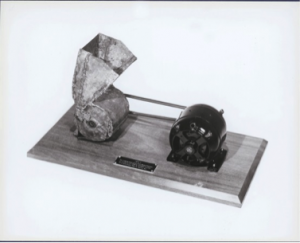Benefits of Garbage Disposers and Myths Dispelled
By Leah Kondes - Spokesman for Insinkerator - Courtesy of KBBonline.com
 The world's first food waste disposer. Invented in Racine Wisconsin by Architect John Hammes in 1927.
The world's first food waste disposer. Invented in Racine Wisconsin by Architect John Hammes in 1927.
This hard-working, under-appreciated appliance has come a long way since it was first invented back in 1927 by an architect in Racine, Wis., named John Hammes. Believe it or not, the photo at left is what the first disposer looked like.
About half the homes in the U.S. have a disposer, and here’s why:
So, what’s keeping the other half of the homes in the U.S. from investing in this handy kitchen helper? Well, there are some long-standing myths about disposers that still need to be dispelled.
About half the homes in the U.S. have a disposer, and here’s why:
- It helps keep kitchens clean, fresh and hygienic – no food waste in the trash can causing an odor to attract pests and fewer trips to the dumpster.
- Putting your food waste down a disposer is more environmentally friendly than putting it in the trash to be hauled to a landfill where it will decompose and release methane (a greenhouse gas).
- A good disposer only costs a few hundred dollars and will last for several years.
So, what’s keeping the other half of the homes in the U.S. from investing in this handy kitchen helper? Well, there are some long-standing myths about disposers that still need to be dispelled.
Disposer Myths
- “Water/energy used by disposers cancel out any environmental benefits.”
- Actually, disposers only use 1 percent or less of a household’s total water consumption and cost on average less than 50 cents a year in electricity.
- “Using a disposer is bad for a home’s plumbing.”
- The fact is, food waste is 70 percent water. If you have a modern disposer with multiple stages of grind and you use your disposer properly, food waste is virtually liquefied, allowing it to move through your plumbing with ease.
- “My house is on a septic system, so I can’t have a disposer.”
- If your septic system is properly sized and maintained, this shouldn’t be a problem. If your septic system can handle a dishwasher, a washing machine, and toilets, it can handle a disposer.
Disposer and Septic System Care
There are a few things we can do to make sure our disposer and septic system give us the best performance.
- Do not put things down the disposal that are not easily ground and digested - These include: silverware, melon rinds, peels from bananas, oranges, lemons, & limes, coffee grounds, egg shells, & large amounts of cooking grease.
- If you have a large quantity of anything, maybe carrot or potato peels as an example, feed them in gradually with the water running and the disposer on, do not stuff them all in at once and hit the switch.
Disposer Odors
Over time, food particles may accumulate in the grind chamber and baffle.
An odor from the disposer is usually a sign of food buildup, caused by insufficient water flow during and after disposer use.
To clean the disposer:
An odor from the disposer is usually a sign of food buildup, caused by insufficient water flow during and after disposer use.
To clean the disposer:
- Turn off disposer and disconnect power supply.
- Reach through sink opening and clean underside of splash baffle and inside upper lip of grind chamber with scouring pad.
- Place stopper in sink opening and fill sink halfway with warm water.
- Mix a one pound box of baking soda with water. Turn disposer on and remove stopper from sink at same time to wash away loose particles.
Disposers may also be cleaned with Disposer Care®. This product is not sold by InSinkErator but is generally available in major home centers, hardware and grocery stores. For more information on Disposer Care, contact Summit Brands at 1-888-476-6688 or www.disposercare.com.
